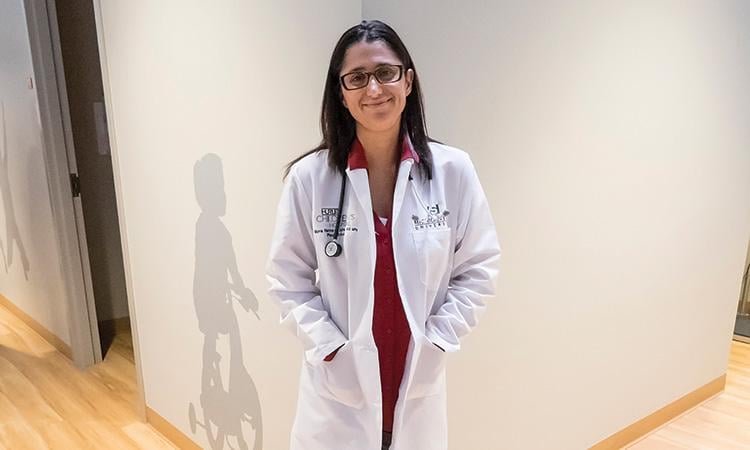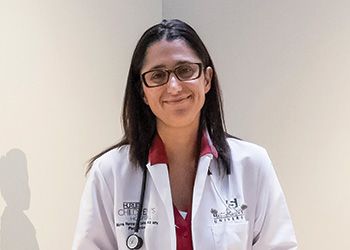On a sweltering Wednesday in June, Dr. Mona Hanna-Attisha steps into the sunlight for the first time in hours. She marches toward her car, carrying a hefty backpack and filled with fierce determination.
The director of the pediatric residency program at Hurley Children’s Hospital in Flint as well as an associate professor of pediatrics at the MSU College of Human Medicine, Hanna-Attisha—or “Dr. Mona,” as she is best known—has devoted her morning to seeing a revolving door of pediatric patients. The afternoon hours, meanwhile, are packed with a speech, a meeting and a Skype session with students on the West Coast. If all goes well, she’ll settle into her seat at the family dinner table by 6 p.m. alongside her husband and two children, now ages 11 and 13.
Tomorrow and the next day will bring more of the same for Hanna-Attisha.
 More than five years after exposing toxic levels of lead in the water entering Flint homes, a journey she recounts in her 2018 memoir, “What the Eyes Don’t See: A Story of Crisis, Resistance, and Hope in an American City,” Hanna-Attisha remains a woman on the move—and happily so.
More than five years after exposing toxic levels of lead in the water entering Flint homes, a journey she recounts in her 2018 memoir, “What the Eyes Don’t See: A Story of Crisis, Resistance, and Hope in an American City,” Hanna-Attisha remains a woman on the move—and happily so.
Hanna-Attisha’s family came to the United States from Iraq when she was four, fleeing the dictatorship of Saddam Hussein. That personal history fueled her push for social justice. “We came for opportunity, freedom and democracy, for the American dream. I am a first-generation immigrant who is every day grateful to be in this country, but also very aware of what injustices can be.”
Her understanding that people, particularly children, need compassionate, motivated champions sparked her health care pursuits. “I went into medicine and pediatrics at Michigan State because of its commitment to service. That’s why I’m here: to be an advocate for children. My constituency is children and I’m tasked to get resources for and to care for children, and that’s work that gives me purpose and energy,” she said.
Though a self-professed lover of the written word, Hanna-Attisha never envisioned penning a book—that is, until her role in the Flint water crisis. “I had no other option. I needed to put pen to paper and share not only what happened in Flint, but the larger lessons regarding where our nation is and where it needs to be.”
“What the Eyes Don’t See” covers the nearly two months before Flint captured international headlines and media flooded the city located 45 miles northeast of East Lansing. Stonewalled, stalled and marginalized by public health officials, Hanna-Attisha, in her 384-page memoir recounts her feelings of guilt and anger, frustration and betrayal amid one of the most damning public health disasters of contemporary times. It’s a story that begs to be told.”
Taken quite literally, “What the Eyes Don’t See” references the lead in Flint’s water supply, but also the people and places society largely overlooks. “There are places and problems everywhere that we have closed our eyes to.”
As a mother of two children, Hanna-Attisha could not ignore the issues with Flint’s water supply. “I know what it’s like to care for children, to hope their futures are bright and happy. The kids I see at the clinic are no different than my own and that compelled action.”
While Hanna-Attisha’s memoir recounts her role in the Flint water crisis, it is also—quite intentionally—a call for readers to embrace roles as activists and resistors. “We are facing deep crises in our nation right now—democracy, austerity, environmental justice, racism and more—and we all need to work together to bring about hope in our communities. This book is a rallying cry to folks no matter where they are, what they do, what their profession is or how they came to this country, that we all have a role to play to make this world a better place.”





